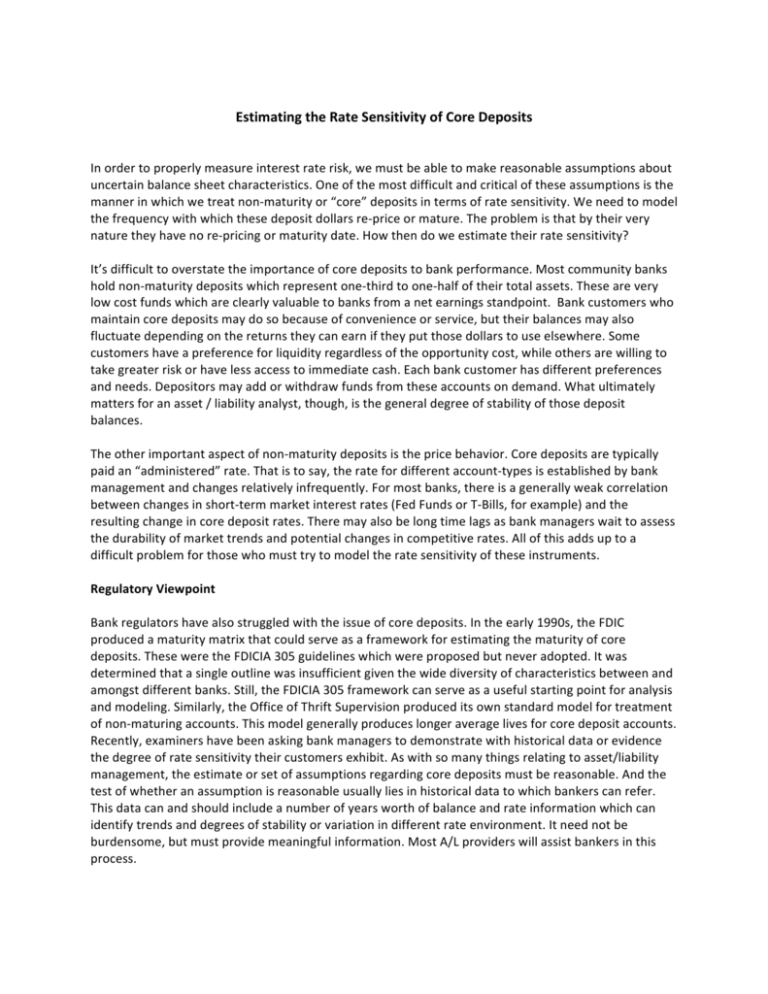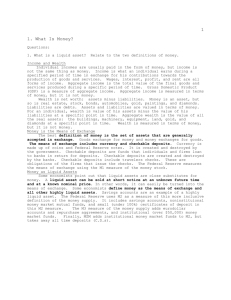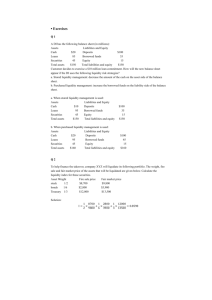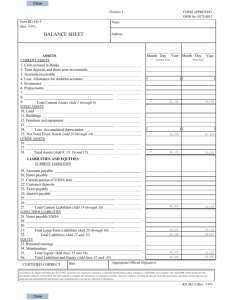Estimating the Rate Sensitivity of Core Deposits
advertisement

Estimating the Rate Sensitivity of Core Deposits In order to properly measure interest rate risk, we must be able to make reasonable assumptions about uncertain balance sheet characteristics. One of the most difficult and critical of these assumptions is the manner in which we treat non-­‐maturity or “core” deposits in terms of rate sensitivity. We need to model the frequency with which these deposit dollars re-­‐price or mature. The problem is that by their very nature they have no re-­‐pricing or maturity date. How then do we estimate their rate sensitivity? It’s difficult to overstate the importance of core deposits to bank performance. Most community banks hold non-­‐maturity deposits which represent one-­‐third to one-­‐half of their total assets. These are very low cost funds which are clearly valuable to banks from a net earnings standpoint. Bank customers who maintain core deposits may do so because of convenience or service, but their balances may also fluctuate depending on the returns they can earn if they put those dollars to use elsewhere. Some customers have a preference for liquidity regardless of the opportunity cost, while others are willing to take greater risk or have less access to immediate cash. Each bank customer has different preferences and needs. Depositors may add or withdraw funds from these accounts on demand. What ultimately matters for an asset / liability analyst, though, is the general degree of stability of those deposit balances. The other important aspect of non-­‐maturity deposits is the price behavior. Core deposits are typically paid an “administered” rate. That is to say, the rate for different account-­‐types is established by bank management and changes relatively infrequently. For most banks, there is a generally weak correlation between changes in short-­‐term market interest rates (Fed Funds or T-­‐Bills, for example) and the resulting change in core deposit rates. There may also be long time lags as bank managers wait to assess the durability of market trends and potential changes in competitive rates. All of this adds up to a difficult problem for those who must try to model the rate sensitivity of these instruments. Regulatory Viewpoint Bank regulators have also struggled with the issue of core deposits. In the early 1990s, the FDIC produced a maturity matrix that could serve as a framework for estimating the maturity of core deposits. These were the FDICIA 305 guidelines which were proposed but never adopted. It was determined that a single outline was insufficient given the wide diversity of characteristics between and amongst different banks. Still, the FDICIA 305 framework can serve as a useful starting point for analysis and modeling. Similarly, the Office of Thrift Supervision produced its own standard model for treatment of non-­‐maturing accounts. This model generally produces longer average lives for core deposit accounts. Recently, examiners have been asking bank managers to demonstrate with historical data or evidence the degree of rate sensitivity their customers exhibit. As with so many things relating to asset/liability management, the estimate or set of assumptions regarding core deposits must be reasonable. And the test of whether an assumption is reasonable usually lies in historical data to which bankers can refer. This data can and should include a number of years worth of balance and rate information which can identify trends and degrees of stability or variation in different rate environment. It need not be burdensome, but must provide meaningful information. Most A/L providers will assist bankers in this process. relatively that bank management makes when measuring i Managing capital at risk involves measurement of what’s commonly referred to as Economic Value of Equity or EVE. This is a concept that gauges the impact of interest rate changes on fair market values of asset, liabilities, and equity. EVE captures the change in economic value of the bank even though that change may not be reflected in the bank’s accounting books and records. Consider the underlying market value of bonds in the investment portfolio. We all know that if interest rates rise, bond prices fall. This is the manifestation of price risk. What is not as clear, however, is the degree to which that change in the economic value of the investment portfolio value will impact the overall value of the balance sheet. Note that loans also have a theoretical economic value just like bonds. If market interest rates rise sharply, then existing fixed-­‐rate loans will be worth less from an economic standpoint. Indeed, any financial asset or liability… anything with a cash flow… will have an underlying value that fluctuates as interest rates move up and down. Whereas the value of assets will move inversely to interest rates, the value of liabilities will move directly with rates. This is because existing fixed rate deposits become more valuable to the institution if market interest rates fall. So how do we calculate Economic Value of Equity? Remember that the standard accounting relationship is ‘Assets equals Liabilities plus Owners Equity’. If we can calculate the fair market value of assets and liabilities, then we can simply back into the value of equity capital. Moreover, if we can project the changed value of assets and liabilities under different rate environments, we can measure projected changes in EVE as well. This is precisely what we do when we measure interest rate risk from the economic perspective. The reason that the market value of bank assets and liabilities is affected by rate changes is that the net present value of future cash flows, and in some cases the cash flows themselves, is altered. A good asset / liability management model will use standard financial discounting methodology to derive fair value of assets and liabilities, then shock interest rates up and down 100, 200, and 300 basis points and recalculate values in order to measure projected changes. The effect of these changes on various equity ratios is reported along with the percentage change in fair market value for equity among other metrics. What the examiners normally focus on is the percentage change in fair market value (or EVE) under different rate shocks. In some ways the economic value approach provides a broader scope than the earnings approach, since it captures all anticipated cash flows. Monitoring changes in the Economic Value of Equity is valuable in that it provides a comprehensive measurement of interest rate risk. It captures the effects of optionality and other important influences on value that are not contained in static accounting-­‐type reports. The economic valuation method also reflects those sensitivities across the full maturity spectrum of the bank’s assets and liabilities. For all its benefits, EVE also suffers from a number of disadvantages. For example, the sensitivity of the EVE to changes in interest rates gives no information about the exact timing of rate risk. Managers need to know IRR timing as well as the quantity. Risk exposures may exist in the next twelve months, but may be entirely different over the subsequent two years. EVE simply shocks the balance sheet instantaneously and calculates overall value-­‐at-­‐risk. Another downside is the fact that EVE relies on methodological and calculation assumptions which may or may not turn out to be accurate. The most notable of these is the discount rate assumptions that are used to calculate the present value of assets and liabilities. It is relatively easy to calculate the market value of a bond with a fixed rate of interest and a fixed maturity. It is considerably more difficult and far less objective to calculate the economic value of a saving account with no fixed maturity and an administered rate that is subject to change by bank management. It is not uncommon for a bank to show earnings improvement, but economic value deterioration, in a rising versus a falling rate environment. A bank such as this would be more profitable if rates rise, but the economic value of its equity would be lower. The dynamics of cash flow re-­‐pricing, embedded options, rate caps or floors, or a variety of other factors can cause this disconnect. This is why we separate earnings simulation from EVE. Measuring interest rate risk involves tracking dynamic and complex relationships within a bank’s balance sheet. To do it properly, we must have good input, reasonable assumptions, and sound methodology. The calculation and monitoring of changes in the economic value of equity is an important part of the process. And in the final analysis, we cannot properly manage the financial risk of our bank without a clear understanding of these measurements. Jeffrey F. Caughron







